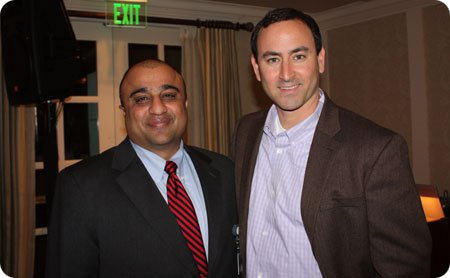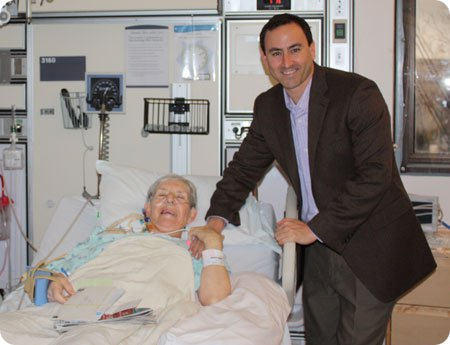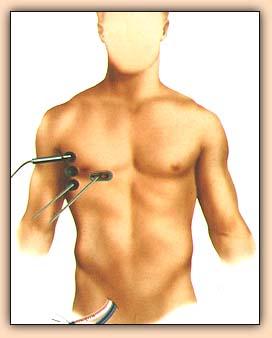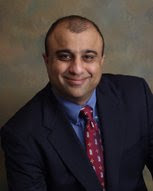Friday, May 20, 2011
Vital Signs
Kudos - A Thank you to Dr. Junaid Khan and all the Staff at the Alta Bates Summit Cardiac ICU
"I met you at the presentation for people who have heart murmurs in Lafayette back in February. I was there to support a friend of mine who has a murmur and also to meet and thank Adam Pick and Dr. Khan, who have helped me in my own journey with heart disease. Dr. Junaid Khan replaced my mitral valve using the minimally invasive procedure and it has literally restored my life.
"With the exception of the 10 months before my surgery, when I was unknowingly in heart failure, I have always been super athletic and outdoorsy and I really thought I'd never feel well enough to hike and run again. I was wrong! Four weeks post op I went for a hike, was back at the gym by six weeks and at nine months I started thinking about how I would celebrate my 1 year anniversary.
"I discovered the American Heart Association sponsored a training program/fund raiser and that the event was going to be on May 1st - a year and a day after my surgery so I signed up. I had a great time training, raised a bunch of money and finished the course in just over three hours which is not super fast, but right there with the 'normal' people my age. Attached is the picture of me running.
"Turns out the fund raising event this year is on April 30th which is my 2 year anniversary exactly, so I signed up again :-). I've been having a great time training and am amazed that I feel even better this year than I did last year...my legs get tired before my heart does these days.
"I owe all of this to Dr. Junaid Khan, Dr. Luisa Munoz, and the wonderful nurses in the CIU at Summit - Toni David Wright who got me through that first scary night, Mia Pannell and Adrian Smith and many others whose names escape me - THANK YOU."
Friday, February 25, 2011
American Heart Association Honors Alameda County Students, Schools for Increasing CPR Capacity Within Community
The American Heart Association will recognize two 7th grade students and 30 Alameda County schools on Saturday for outstanding work to increase CPR knowledge and skills within the community.
The students are Wilson Hoang, of Alvarado Middle School in Union City and Winnie Chen, who attends Sunol Glen in Sunol. After receiving training in cardiopulmonary resuscitation (CPR) at school with a CPR Anytime Friends & Family kit, Wilson used his kit to train 96 additional people in CPR. Winnie used her kit to share CPR skills with 51 people.
“These young people are to be commended for their hard work in not only learning the life-saving skill of CPR but in sharing it with the community in such a deep and significant way,” said Junaid Khan, M.D., President of the East Bay Division of the American Heart Association and a cardiac and thoracic surgeon at Alta Bates Summit Medical Center in Oakland. “When someone suffers a sudden cardiac arrest, CPR can double or even triple the chances of survival.”
The 30 schools to be recognized Saturday have offered CPR training to 9,500 7th grade students this school year through Alameda County’s new CPR 7 initiative. Each student received his or her own CPR Anytime Friends & Family kit, containing an instructional CD and an inflatable manikin. The kits were developed by the American Heart Association and are designed to teach CPR skills in 22 minutes. Students were challenged to use their personal kits to train additional people. Wilson and Winnie were the county leaders in bringing CPR to others.
The schools receiving recognition are: Albany Middle School; Longfellow Middle School; Martin Luther Middle School; Willard Middle School; Canyon Middle School; Creekside Middle School; Eleanor Fallon Middle School; Horner Junior High; Walters Junior High; Christensen Middle School; East Ave. Middle School; Junction K-8; Mendenhall Middle School; Joe Mitchell School; Alvarado Middle School; Cesar Chavez Middle School; Alliance Academy; Montera Middle School; Roots International Academy; United for Success; Piedmont Middle School; Hart Middle School; Harvest Park Middle School; Bancroft Middle School; John Muir School; Bohanan Middle School; Edendale Middle School; Washington Manor Middle School; Sunol Glen; and Mountain House School.
Each year in the United States, Emergency Medical Services treats nearly 300,000 victims of out-of-hospital cardiac arrest. Less than 8 percent of them survive, and less than one-third receive bystander CPR. Without immediate CPR, a person has very little chance of surviving.
The students and schools will be recognized Saturday evening during the UC Berkeley women’s basketball game. Game time is 7:30 p.m.
Learn more about CPR at www.heart.org/CPR. CPR Anytime kits ($34.95) may be purchased at www.ShopCPRAnytime.org.
Thursday, February 24, 2011
Valve Clinic Tour: Dr. Junaid Khan Educates Patients About Heart Murmurs & Minimally Invasive Treatment
Last Thursday, I found myself at Alta Bates Summit Medical Center in Oakland, California. My reasons for traveling to Northern California were two-fold. First, I wanted to meet Dr. Junaid Khan, a leading minimally invasive heart valve surgeon on the West Coast. Second, I was asked to speak at a a special, educational seminar titled, “For People With Heart Murmurs”.

Dr. Junaid Khan and Adam Pick at “For People With Heart Murmurs” Seminar
My first meeting of the day was with Dr. Khan. I quickly learned several interesting facts about the surgeon who trained at UCLA Medical Center.
- Dr. Khan performed over 250 cardiac procedures in 2010.
- Over 60% of his surgeries are valve-related. Dr. Khan tends to perform more mitral valve surgery than aortic valve surgery.
- Dr. Khan’s mitral valve repair rate is about 70% while the national average is about 42%.
- Alta Bates Summit Medical Center was the only cardiac center to receive a “three-star” rating from Consumer Reports.
- Dr. Khan is a dedicated father and husband. Currently, Dr. Khan coaches the baseball teams for his two sons.
Personally, I was most intrigued by Dr. Khan’s adoption and competence specific to minimally invasive valve procedures. While Alta Bates Summit Medical Center has a Da Vinci robot, Dr. Khan does not use the machine for valve procedures. Instead, Dr. Khan typically uses the port access approach… if the candidate qualifies.
“A median sternotomy is a great operation. However, the minimally invasive port access approach offers several advantages including less physical trauma, less pain and shorter hospital stays.” — Dr. Junaid Khan
It appears that Dr. Khan’s reputation for this type of procedure is growing rapidly. Several patients have traveled to Alta Bates Summit from Arizona, Colorado, Washington, Oregon and Florida to have Dr. Khan perform their surgery.
Dr. Khan’s Pre-Op and Post-Op Support Team
Next, I met with Dr. Khan’s pre- and post-operative teams. During this two-hour chat and tour, the team (JoMarie, Penny, Olvera, Leah, Provena, Connie, etc.) shared their unique, turn-key approach for managing and monitoring the patient’s surgical cycle – from respiratory therapy, to occupational therapy, to nutrition counseling, to cardiac rehabilitation. In addition to their patient-centric approach, I also noticed their commitment to the caregivers. That said, the cardiac center offers caregivers many complimentary amenities including a nap room, children’s rooms, computers and more.

On Tour Through The Alta Bates Summit Cardiac Center
A Surreal Moment with Gretchen Gillfillan…
An unexpected, personal highlight occurred when I entered the intensive care unit. There, I met Gretchen Gillfillan, a 79-year old retired school teacher who had aortic valve replacement just 24 hours earlier — using a pig (porcine) valve. As I walked by Gretchen’s room, I noticed her eyes tighten on me. Gretchen then raised her hand, smiled and said, “I… I recognize you… Oh yeah… I read your book… Thank you soooooo much!”

Gretchen Gillfillan and Adam Pick in the Intensive Care Unit
There are no words to describe that heart-warming exchange of words. Without a doubt, Gretchen made my day, my month, my year. Most importantly, Gretchen is now home from the hospital, doing very well in her early recovery.
The Educational Seminar, “For People With Heart Murmurs”
To educate the community about heart valve disease, Dr. Khan hosted a complimentary seminar for patients at the Lafayette Park Hotel – just outside of Oakland – on Thursday night.
Even with the rain, the event was filled with patients and caregivers at maximum capacity. During the ninety-minute session, Dr. Khan and I shared our unique perspectives on heart valve disease and heart valve surgery. Needless to say, I learned a lot from Dr. Khan’s presentation about (i) the progression of valve disease (aortic stenosis and mitral regurgitation), (ii) the risks of not treating valvular defects, (iii) minimally invasive treatment using the port access approach and (iv) the future of percutaneous valve therapy and much, much more.

The Port Access Approach To Minimally Invasive Valve Surgery
After an interactive questions and answer session with the attendees, the event ended with a book signing. There, I was able to meet one-on-one with many patients and their caregivers.

Great Job To Alta Bates Summit Medical Center!!!
Even with the rainy Oakland weather and the very delayed flight home to Los Angeles, I was thrilled to have this special time with Dr. Khan, the staff at Alta Bates Summit Medical Center and the patients in their community. Thanks so much to Dr. Khan and his team for their dedication to and pursuit of healthy hearts. To learn more about Dr. Khan, please click here.
Keep on tickin!
Monday, February 14, 2011
Wednesday, October 20, 2010
State Releases Data for Heart Bypass Surgery Death Rates


The heart muscle is supplied blood through the coronary arteries.
The left coronary artery supplies blood to the left ventricle.
The right coronary artery supplies blood to the right ventricle.
Today the state released its annual data on death rates in California hospitals for coronary artery bypass graft surgeries, a common procedure used to treat heart disease.
The data is interesting because it's one of the first and few surgical death rates that hospitals are required to report so it gives consumers some insight into where they are more or less likely to die if they have to undergo the procedure. The results are based on surgeries performed in 2007.
The report for the first time also includes hospital ratings based on their risk-adjusted post operative stroke rates for the years 2006-2007. It singles out Alta Bates Summit Medical Center's Oakland campus for better than average performance on this measure.
Public outcome reporting by hospitals seems to have an impact. Since the state Office of Statewide Health Planning and Development started releasing the data in 2003, death rates for coronary bypass surgery have dropped 19 percent.
Heart bypass surgery is one of the top 10 surgeries in California in terms of cost, and preliminary 2008 data shows patients have a chance of dying of about 2.2 percent.
While no hospital performed better than the state average on the surgical mortality rates, four hospitals performed worse: Enloe Medical Center in Chico; Los Angeles County Harbor - UCLA Medical Center; St. Joseph's Medical Center in Stockton and Valley Presbyterian Hospital in Van Nuys. To check out the full report, go here.
Posted By: Victoria Colliver (Email) October 19 2010 at 11:18 AM
Read more: http://www.sfgate.com/cgi-bin/blogs/chronrx/detail?entry_id=74937&tsp=1#ixzz12v8bjKcG
CA Reports Stroke Rates in Bypass Surgery Data
 http://www.healthleadersmedia.com/content/QUA-257919/CA-Reports-Stroke-Rates-in-Bypass-Surgey-Data
http://www.healthleadersmedia.com/content/QUA-257919/CA-Reports-Stroke-Rates-in-Bypass-Surgey-Data--------------------------------------------------------------------------------
CA Reports Stroke Rates in Bypass Surgery Data
Cheryl Clark, for HealthLeaders Media , October 20, 2010
California has recently become the first state to report hospital data on rate of stroke in patients after coronary artery bypass graft (CABG) surgery, and the results show a wide variation among 121 hospitals.
The new measure comes in the state's regular hospital data report for 2007 on CABG mortality, which has been issued eight times since 2001 when the first report covered hospital performance for 1998-99.
Joe Parker, director of healthcare outcomes for the California Office of Statewide Health Planning and Development, which issued the report, says that stroke was included this time in the CABG data because better hospital practices can reduce the number of patients who develop the complication, a known risk factor in these procedures.
"We want to be selecting something over which there is a possibility of control and improvement by a hospital," he says. "Stroke was selected because it is an important negative outcome of CABG surgery, and one that has a huge impact on families of those who care for stroke victims, as well as on the patients."
Of the 121 hospitals in the state that perform bypass graft surgery, one hospital had the lowest rate of stroke complications, Alta Bates Summit Medical Center, Summit Campus, a 337-bed hospital in Oakland.
Parker says that he visited with Russell Stanten, MD, cardiothoracic surgeon at Alta Bates, to learn what the hospital does to prevent stroke in these patients. He says Stanten replied that the hospital screens each patient for carotid disease, "and if they find it they deal with it prior to the CABG surgery." Additionally, Alta Bates surgeons also make sure the patients have transesophageal echocardiograms performed intraoperatively.
Additionally, Junaid Khan, MD director of cardiovascular services at Alta Bates, says a crucial reason for the hospital's success is in making sure that every anesthesiologist on a CABG case is board certified in echocardiography. The hospital, which does about 800 open heart procedures a year—many of them CABG—also limits the number of anesthesiologists and others who are allowed to work on these patients only "to those who do a lot of them."
"You may have people who are doing 10 cardiac surgeries a year. Ours are doing 100 cardiac cases a year," Khan says. "We also work with the perfusionists to make sure they maintain adequate pressure,"
The state's report says that risk adjusted post-operative stroke rates for five hospitals were worse than average:
1.Los Angeles County Harbor-UCLA Medical Center (4.17%)
2.Tri-City Medical Center in Oceanside (3.97)
3.Sharp Memorial Hospital in San Diego (3.15%)
4.Memorial Medical Center of Modesto (2.63%)
5.Sutter Memorial Hospital in Sacramento (2.43%)
In a letter to the state agency, Robert Adamson, MD, medical director of the cardiac transplant program at Sharp, says that in 2006, "we noted an unusual cluster of six strokes. Each case was individually reviewed and no trends or common causes could be identified," but "strongly influenced our results for the two-year period."
He says that in 2007, the incidence of stroke in this population was half that in 2006 and zero in 2008. "In view of this, we feel that the rating, while accurate in number, does not reflect our current performance in this area."
For Harbor-UCLA, Bassam Omari, MD, chief of the division of cardiothoracic Surgery, wrote the agency explaining that the hospital has discovered discrepancies in risk factors reported for its CABG patients, which "adversely affected our expected mortality and morbidity."
Other reasons for Harbor-UCLA's high rates, he wrote, dealt with the high number of Jehovah's Witnesses "whose beliefs preclude our ability to provide life-saving blood transfusions" and said the hospital failed to adequately count those patients who had a prior stroke, which put them at greater risk.
For bypass graft mortality without stroke, no hospital performed significantly better than the state average. But Enloe Medical Center in Sacramento, Los Angeles Co. Harbor—UCLA Medical Center, St. Joseph's Medical Center in Stockton and Valley Presbyterian Hospital in Van Nuys, performed significantly worse.
The California agency keeps the largest public outcomes database in the country and is an important source of comparative information for performance.
Other significant findings from the report include the following:
•Of the 30,379 patients who underwent isolated CABG surgery, 405 experienced a stroke in which symptoms lasted for 72 hours or longer, a rate of 1.33%, which is close to the national rate of 1.4% reported by the Society of Thoracic Surgeons.
• The operative mortality rate for CABG surgery in the state in 2007 was 2.35%, slightly higher than 2.2% for 2006, but much lower than in the prior three years 3.1%, 3.3% and 2.9%.
•There were 347 operative deaths among the 14,756 CABG surgeries during 2007.
This latest report also scored hospitals on their use of the internal mammary artery (IMA) during CABG procedures, a practice associated with better surgical outcomes but may take longer. Five hospitals had low rates of IMA usage, including Citrus Valley Medical Center in Covina, Dameron Hospital in Stockton, Lakewood Regional Medical Center in Lakewood, Suttter Medical Center in Santa Rosa and Tri-City Medical Center in Oceanside.
Parker says that use of the IMA in bypass graft surgery is longer lasting and is associated with lower mortality, but takes about 15 minutes longer to perform than traditional use of the radial artery or saphenous vein, and that may be why some surgeons fail to use it. In 2007, the state had a 93.7% IMA usage, a 4% increase since 2003.
With its next report the state hopes to add in comparative data on how many CABG patients go into renal failure and require post-operative dialysis, another complication. Renal failure occurs in between 1% and 2% of CABG cases, on average, he says.
Debby Rogers, vice president for Quality and Emergency Services for the California Hospital Association, says her organization is "pleased that they're issuing reports with more recent data." She noted that the reports indicate a distinct "through the years that care is improving" related to CABG mortality.
--------------------------------------------------------------------------------
Cheryl Clark is a senior editor and California correspondent for HealthLeaders Media Online. She can be reached at cclark@healthleadersmedia.com.
Tuesday, October 12, 2010
American Heart Association honors new research grant recipients and leaders in cardiovascular innovation in the Bay Area
CONTACTS: Linda Tsai, communications director,
(408) 367-9784; linda.tsai@heart.org
(SAN FRANCISCO) – More than 100 people, including prominent leaders and pioneers in the health and medical community, joined together this week evening to honor the American Heart Association’s newest local recipients of cardiovascular research funding at the Four Seasons San Francisco.
The evening reception, made possible with support from Gilead Sciences Inc., is the first ever gathering dedicated to the Association’s Northern California research grant recipients. It is also honored research recipients from the past decade.
Deepak Srivastava, M.D., President of the American Heart Association’s San Francisco Board of Directors, had this message for the awardees, “Young scientists in the room: Never give up. It does not matter if you are a post-doctoral scholar, a medical student or an undergraduate. There are opportunities for you to pursue your dream.” Dr. Srivastava first received American Heart Association funding early in his career; today he serves as Director of the Gladstone Institute of Cardiovascular Disease at the University of California, San Francisco.
Junaid Khan, M.D., President of the Association’s East Bay Board, also knows the value of an early research grant. “I received funding from the AHA as a medical student and it helped define the direction of my medical career.” Today, Dr. Khan is Managing Partner at East Bay Cardiac Surgery, with hospital affiliations at both Alta Bates Summit Medical Center in Oakland and Doctors Medical Center in San Pablo.
This year’s awardees are recipients of nearly $4 million in grants funded by the American Heart Association’s Western States Affiliate. Including funding from the American Heart Association’s National Center, $28 million in AHA research funds was awarded in the past year to Northern California institutions.
The 34 recipients of 2010 AHA Western States funding are:
Children’s Hospital Oakland Research Institute: Mistuni Ghosh, M.S.
Gladstone Institute of Cardiovascular Disease: Nathalie Gaborit, Ph.D.
Palo Alto Institute for Research and Education, Inc: Patricia Nguyen, M.D.
Stanford University and Stanford University School of Medicine: Marion Buckwalter, Ph.D., M.D.; Cindy Chung, Ph.D.; Shijun Hu, Ph.D.; Kiran Khush, M.D.; Josh Knowles, Ph.D., M.D.; Nick Leeper, M.D.; Merritt Maduke, Ph.D.; Foteini Mourkioti, Ph.D.; Mikyoung Park, M.S.; Valeria Vásquez, Ph.D.; Iqin Xiiong, M.D.; Masayuki Yazawa, Ph.D.; Yaozhong Zou, Ph.D.
University California, San Francisco: Gregory Marcus M.D.; Khanh Nguyen, M.D.; Jose Perez, Ph.D.; Sharon Poisson, M.D.; Sven Reischauer, Ph.D.; Carrie Shiau, B.A.; Jeoung-Sook Shin, Ph.D.; James Smyth, Ph.D.; Samantha Stehbens, Ph.D.; Hua Su, M.D.; Monika Suchanek, Ph.D.; Shantel Weinsheimer, Ph.D.; Yafeng Zhang, Ph.D.
UCSF and San Francisco Veterans Affairs Medical Center: Elaine Tseng, M.D.
University of California, Davis: Colleen Clancy, Ph.D.; Javier López, M.D.; Jon Sack, Ph.D.; Fan Yang, B.S.
Tuesday was also a celebration for the Bay Area’s productive cardiovascular research community and the American Heart Association’s commitment to support it.
In addition to Dr. Khan and Dr. Srivastava, other notable speakers Tuesday night included: José Cisneros, Treasurer for the City and County of San Francisco, and Luiz Belardinelli, M.D., Senior Vice President of Cardiovascular Therapeutics, Gilead Sciences Inc.
Dr. Belardinelli, an American Heart Association grant recipient early in his own career, mentioned the importance of giving back to the community.
Dr. Khan gave special recognition to the following attendees for their dedication to and support of the American Heart Association, including:
Rod Starke, Former Chief Science Officer for the American Heart Association
Fredric B. Kraemer, MD, Western States Affiliate Board Member
Hal Barron, Executive Vice President and Chief Medical Officer at Genentech
Shaun Coughlin, Director, Cardiovascular Research Institute at UCSF
R. Sanders "Sandy" Williams, President of The J. David Gladstone Institutes
Mark Hlatky, Professor of Health Research and Policy and of Medicine at Stanford University
Hans Reiser, Senior Vice President, Medical Affairs, at Gilead Science
Patricia Sprincin, Chair of the American Heart Association’s Heart and Stroke Society
John Woods, Executive Vice President and CFO of Union Bank and Chair of the Bay Area Heart Walk
Amanda Wallis-Blue, Chair of the Patron Committee for the Celebrate with Heart Gala.
These individuals are “true leaders in the world of research and leaders within the American Heart Association,” Dr. Khan said.
The American Heart Association is the second largest single funder of cardiovascular research after the National Institutes of Health. The Association has invested more than $3.2 billion nationally in cardiovascular research since 1949.
Tuesday’s event was the first of what will become an annual celebratory gathering to highlight the lifesaving work quietly being carried out every day by so many members of the Bay Area community.
About the American Heart Association
Founded in 1924, we’re the nation’s oldest and largest voluntary health organization dedicated to building healthier lives, free of heart disease and stroke. To help prevent, treat and defeat these diseases — America’s No. 1 and No. 3 killers — we fund cutting-edge research, conduct lifesaving public and professional educational programs, and advocate to protect public health. To learn more or join us in helping all Americans, call 1-800-AHA-USA1 or visit www.heart.org.


